Karen Lewis delivers Chicago Teachers Union 'State of the Union' address to the January 9, 2013 House of Delegates... Vows continued battle for the soul of public education, militant opposition to looming school closings
Chicago Teachers Union president Karen Lewis delivered her annual "State of the Union" address to the union's 800 delegates at the House of Delegates meeting at the Operating Engineers Union hall in Chicago on Wednesday, December 9, 2013. The State of the Union speech was interrupted at several points with applause, and a major round of applause at the finish. [Full disclosure: this reporter is a member of the House of Delegates -- a delegate representing CTU retired teachers -- and was present for the speech reprinted below].
THE COMPLETE DRAFT OF THE SPEECH, PROVIDED BY THE CTU, IS BELOW HERE:
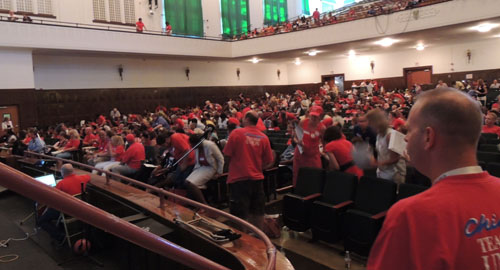 As Karen Lewis told the delegates, the delegates met eleven times during 2012, most of those meetings to hear updates on contract negotiations. Above, one of the largest union meetings in CTU history took place on August 22, 2012 in the large Lane Technical High School auditorium, where Lewis and the officers reported that negotiations between CPS and CTU were going very slowly because the Board still didn't believe, despite the union's strike authorization vote in June, that the union's members would dare to strike for the first time in 25 years. At the August 22 Lane Tech meeting, the delegates voted despite paltry quibbling opposition, to authorize the officers to set a strike date if the Board did not back off its demands to unravel more than 40 years of Chicago teacher contractual rights. Substance photo by George N. Schmidt. The State of the Union. President Karen GJ Lewis, NBCT. Wednesday, January 9, 2013
As Karen Lewis told the delegates, the delegates met eleven times during 2012, most of those meetings to hear updates on contract negotiations. Above, one of the largest union meetings in CTU history took place on August 22, 2012 in the large Lane Technical High School auditorium, where Lewis and the officers reported that negotiations between CPS and CTU were going very slowly because the Board still didn't believe, despite the union's strike authorization vote in June, that the union's members would dare to strike for the first time in 25 years. At the August 22 Lane Tech meeting, the delegates voted despite paltry quibbling opposition, to authorize the officers to set a strike date if the Board did not back off its demands to unravel more than 40 years of Chicago teacher contractual rights. Substance photo by George N. Schmidt. The State of the Union. President Karen GJ Lewis, NBCT. Wednesday, January 9, 2013
Good afternoon brothers and sisters.
Well, brothers and sisters we made it. The world did not come to an end, and contrary to what conservatives and members of the media would have you believe, I have not been roaming the countryside looking for robber barons to maim and kill.
What I have been doing over the last several weeks is spending a considerable amount of time reflecting on this past year — our historic strike and our successful contract campaign. And this afternoon I’d like to share a few of those observations with you.
…and so to the members of this distinguished body gathered here today; to my fellow officers; to the staff; and to our guests assembled here, welcome to the first House of Delegates meeting of the Chicago Teachers Union for the year 2013. Give yourselves a round of applause.
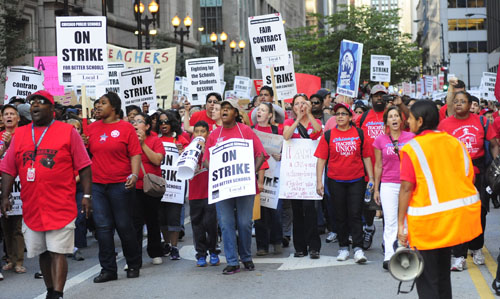 Chicago teachers marched more than 10,000 strong on the first days of the Chicago Teachers Strike of 2012. Above, the teachers' signs proclaim the messages of the strike on September 11, 2012 marching through Chicago's Loop. Substance photo by Graham Hill.Twenty-twelve (2012) was a year of tremendous growth and transformation for the Chicago Teachers Union. We came into our own. Long gone is the media-created image of do nothing, complacent Union leadership eager to cut backroom deals with City Hall and the Board in order to simply “keep labor peace.” Long gone is the image of a teachers union who sits idly by as our students are subjected to failed experiment after failed experiment while saying nothing. Gone is the image of union bosses who talk the talk but do not walk the walk. Long gone is the media-created image of a teachers union too cowardly to take a moral stance for justice. Today, we are united. We stand strong. And though we may internally disagree, externally we remain undivided, and we are unapologetic for demanding the respect we deserve. We have demonstrated our institutional power—or our ability to organize, energize and politicize our members. We have shown the world we can indeed, speak with one voice.
Chicago teachers marched more than 10,000 strong on the first days of the Chicago Teachers Strike of 2012. Above, the teachers' signs proclaim the messages of the strike on September 11, 2012 marching through Chicago's Loop. Substance photo by Graham Hill.Twenty-twelve (2012) was a year of tremendous growth and transformation for the Chicago Teachers Union. We came into our own. Long gone is the media-created image of do nothing, complacent Union leadership eager to cut backroom deals with City Hall and the Board in order to simply “keep labor peace.” Long gone is the image of a teachers union who sits idly by as our students are subjected to failed experiment after failed experiment while saying nothing. Gone is the image of union bosses who talk the talk but do not walk the walk. Long gone is the media-created image of a teachers union too cowardly to take a moral stance for justice. Today, we are united. We stand strong. And though we may internally disagree, externally we remain undivided, and we are unapologetic for demanding the respect we deserve. We have demonstrated our institutional power—or our ability to organize, energize and politicize our members. We have shown the world we can indeed, speak with one voice.
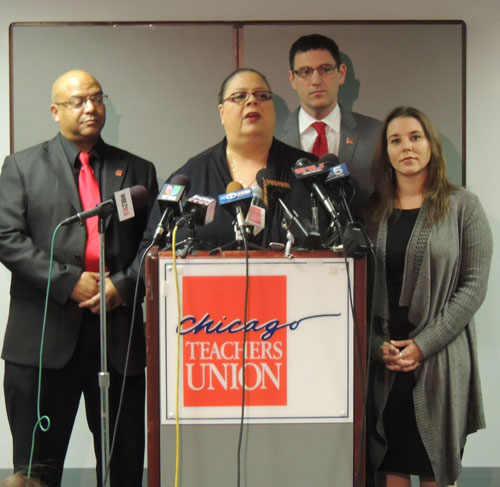 One of the distinguishing features of the new administration at the Chicago Teachers Union was that the union's communications strategy made the union president and the officers regularly available to reporters, despite what had previously been considered the "risks." By the end of 2012, more than a dozen CPS staff members had appeared on television, and dozens of other teachers and union members had also spoken to the media. Above, at the October 4, 2012 press conference at CTU headquarters, the officers announced the vote in favor of the contract. Left to right above: Recording Secretary Michael Brunson, President Karen Lewis, Vice President jesse Sharkey, and Financial Secretary Kristine Mayle. Substance photo by George N. Schmidt.What does democracy look like — a sea of red on May 23rd, bursting the insides of the Auditorium Theatre and streaming 10,000 strong into the streets of Chicago.
One of the distinguishing features of the new administration at the Chicago Teachers Union was that the union's communications strategy made the union president and the officers regularly available to reporters, despite what had previously been considered the "risks." By the end of 2012, more than a dozen CPS staff members had appeared on television, and dozens of other teachers and union members had also spoken to the media. Above, at the October 4, 2012 press conference at CTU headquarters, the officers announced the vote in favor of the contract. Left to right above: Recording Secretary Michael Brunson, President Karen Lewis, Vice President jesse Sharkey, and Financial Secretary Kristine Mayle. Substance photo by George N. Schmidt.What does democracy look like — a sea of red on May 23rd, bursting the insides of the Auditorium Theatre and streaming 10,000 strong into the streets of Chicago.
What does democracy sound like — the united voices of teachers, paraprofessionals and clinicians unafraid to speak up for themselves and others? What does democracy feel like – it feels liberating. It feels just fine.
Yes, this is a different CTU, and I know that still makes some of us uncomfortable. One could say we have quickly moved beyond the adolescent stages of labor innocence and have now matured into labor adulthood. We are on the main stage now. We have made a mark—a big mark. And the CTU has made the distinct connection between teachers unions and social justice. There can be no separation of the two—teachers unions and social justice. If we are to survive, this must be a symbiotic relationship. And as I teach in Chemistry, when two substances are combined, both are changed.
We have passed the starting mark and we are well beyond “go” in this education justice fight. And while the fight to save public education (and public assets) from being raided by politically-connected corporate leaders is happening all around the country, most eyes are on Chicago.
The opposition here is not only strong it is also unique. We were told we could never win; and that our opponents were too strong and would never suffer defeat.
They were wrong. You know why — because truth will always triumph over lies. Justice will always prevail over injustice. Solid research will expose a million inconsistencies. Organizing and communicating directly with those impacted by the decisions we make will always defeat well-funded misinformation campaigns and ill-suited propaganda. They were wrong.
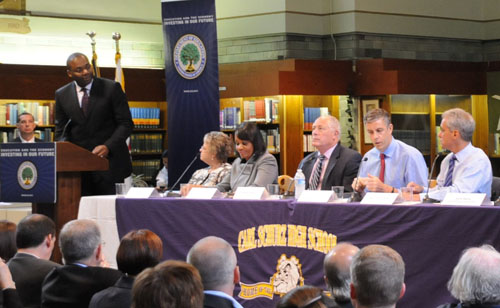 As late as September and October 2011, Chicago's corporate media routinely published the propaganda output of Chicago's rulers as if they were ipso facto fact. Above, on September 9, 2011, then Chicago Schools Chief Executive Officer Jean-Claude Brizard (far left at podium) gives his remarks on the opening of school to the head table at Carl Schurz High School in Chicago. Seated at the main table that morning were the head of the Illinois Education Association (whose "school reform" ideas included bashing Chicago teachers), State Senator Kimberly Lightford (whose SB7 legislation required the the CTU get a vote of 75 percent of its members to authorize a strike), Governor Pat Quinn (who betrayed the CTU after teacher union votes helped elect him in 2010), U.S. Secretary of Education Arne Duncan (who was exporting the Chicago plan across the USA as "Race To The Top"), and Chicago Mayor Rahm Emanuel, who was orchestrating a year-long, sometimes obscene, attack on Chicago teachers and the Chicago Teachers Union. The event above was part of a bus tour Duncan was taking to promote the opening of schools under the business slogan "investing in our future," as if the sole objective of public education could be measured, as Duncan believes and promotes, based on simplistic "business models." Substance photo by George N. Schmidt. For many of our brothers and sisters around the country who are battling their own horde of school reformers, the CTU provides the necessary illumination on how coordinated and well-funded these attacks are. Our AFT brothers and sisters are depending on us to show them how to fight back, how to strengthen their locals, and how to grow their leadership from their rank-and-file. People from as far away as Denmark, France, London and South Africa are asking us “how we did it” — meaning how we accomplished so much, given we were considered the underdogs in this fight.
As late as September and October 2011, Chicago's corporate media routinely published the propaganda output of Chicago's rulers as if they were ipso facto fact. Above, on September 9, 2011, then Chicago Schools Chief Executive Officer Jean-Claude Brizard (far left at podium) gives his remarks on the opening of school to the head table at Carl Schurz High School in Chicago. Seated at the main table that morning were the head of the Illinois Education Association (whose "school reform" ideas included bashing Chicago teachers), State Senator Kimberly Lightford (whose SB7 legislation required the the CTU get a vote of 75 percent of its members to authorize a strike), Governor Pat Quinn (who betrayed the CTU after teacher union votes helped elect him in 2010), U.S. Secretary of Education Arne Duncan (who was exporting the Chicago plan across the USA as "Race To The Top"), and Chicago Mayor Rahm Emanuel, who was orchestrating a year-long, sometimes obscene, attack on Chicago teachers and the Chicago Teachers Union. The event above was part of a bus tour Duncan was taking to promote the opening of schools under the business slogan "investing in our future," as if the sole objective of public education could be measured, as Duncan believes and promotes, based on simplistic "business models." Substance photo by George N. Schmidt. For many of our brothers and sisters around the country who are battling their own horde of school reformers, the CTU provides the necessary illumination on how coordinated and well-funded these attacks are. Our AFT brothers and sisters are depending on us to show them how to fight back, how to strengthen their locals, and how to grow their leadership from their rank-and-file. People from as far away as Denmark, France, London and South Africa are asking us “how we did it” — meaning how we accomplished so much, given we were considered the underdogs in this fight.
Before I can tell them what we did to get where we are I have to tell them where we came from. What we used to be, so they’ll know just how far we’ve come. You have to know where you’ve been sometimes before you can know which way you ought to go. It is important to put our work over the past year — or two and a half years — in context. Change does not happen in a vacuum. It is precipitated by something. Somewhere there’s a catalyst. So what was the catalyst for our tremendous transformation — from a do-nothing Union, to a do something Union? What moved us from a place of fear and complacency into becoming the leading voices in these United States in the forefront fighting against misguided education reform? How did that happen?
Ralph Waldo Emerson said, “When you do a thing, do it with all your might. Put your whole soul into it. Stamp it with your own personality… Nothing great was ever achieved without enthusiasm.”
That, brothers and sisters, pretty much sums up our approach to guiding this Union into its rebirth. When we took this job in June of 2010, none of us had ever been Union bosses before. We had expectations of our team but we didn’t really know what to expect. We were bound to make mistakes. And we have. We were bound to stumble. And we did.
When we sought this office and were elected by our peers and colleagues to do this job, we knew we had yet to face the hard part. But I can tell you, brothers and sisters, the four of us, are committed to do this job with all of our might. We put our souls into it. As you know our team is one that believes in justice. We believe in confronting those who seek to put thousands of us out of work and shut down our schools and destabilize our students and communities. We don’t believe in letting the Board run roughshod over us while we just sit here and take it. That’s not who Karen Lewis, Jesse Sharkey, Kristine Mayle or Michael Brunson are. You elected fighters, thinkers and workers, committed, to doing the hard job. And, brothers and sisters I can tell you it’s hard to stand in the place of leadership particularly at a time when so much is at stake. This ain’t no crystal stair.
So, like Emerson said, we put our souls into it. We stamped the CTU with our own personality. We created a research department. We created an organizing department. We did not understand how a labor union could exist without organizers. As educators, we did not understand how our Union could make its arguments without research. So we added a team of researchers to delve into the facts. So when they made claims about the budget or about some arbitrary policy, we were able to dispute those claims with the truth. Now we’re the ones issuing reports that the Board reacts to—not the other way around.
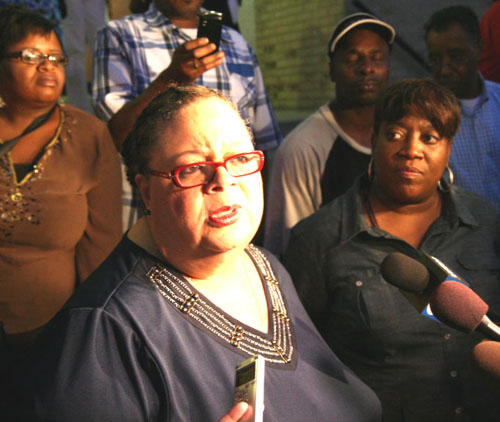 Following her June 2010 election, CTU President Karen Lewis regularly held public press conferences where reporters could ask her questions, a stark contrast to CPS practice under two successive "chief executive officers," who try to manipulate reporters by hosting controlled media events and issuing press statements from flacks. Part of the changes in the CTU came with the reorganization of the union's growing communications department. Above, Lewis speaks to reporters on August 28, 2012, two weeks before the strike began, at a South Side church event on the anniversary of the signing of the Emancipation Proclamation. Standing beside Lewis (right in the above photograph) is CTU Communications Coordinator Stephanie Gadlin. The constant work of the CTU organizing and communications department to reach out in all Chicago communities on issues that affect the children resulted in overwhelming support for the teachers during the strike of 2012, despite massive media campaigns against the CTU and its leadership. Substance photo by Kati Gilson. We strengthened our communications department in August 2011 by bringing in a professional media strategist. In one short year, as a result of our new strategic communications program, the union’s image has improved dramatically, with nearly two-thirds of voters reporting a favorable impression. Today, 44 percent of all taxpayers have a favorable impression of me—a dramatic increase when only 21 percent of the public felt that way just a short year ago. Even the anti-labor, Chicago Tribune, had to take time off from its attacks on us, to admit that Chicagoans now sided with teachers on just about every issue relating to our public school system. So we made sure that our rank-and-file were front and center in the press. Teachers, paraprofessional and clinicians were given media training and cut loose in this market. They told our stories. They spoke our pain. And now because of our improved image and media presence, parents and the City did not turn on us when we went on strike.
Following her June 2010 election, CTU President Karen Lewis regularly held public press conferences where reporters could ask her questions, a stark contrast to CPS practice under two successive "chief executive officers," who try to manipulate reporters by hosting controlled media events and issuing press statements from flacks. Part of the changes in the CTU came with the reorganization of the union's growing communications department. Above, Lewis speaks to reporters on August 28, 2012, two weeks before the strike began, at a South Side church event on the anniversary of the signing of the Emancipation Proclamation. Standing beside Lewis (right in the above photograph) is CTU Communications Coordinator Stephanie Gadlin. The constant work of the CTU organizing and communications department to reach out in all Chicago communities on issues that affect the children resulted in overwhelming support for the teachers during the strike of 2012, despite massive media campaigns against the CTU and its leadership. Substance photo by Kati Gilson. We strengthened our communications department in August 2011 by bringing in a professional media strategist. In one short year, as a result of our new strategic communications program, the union’s image has improved dramatically, with nearly two-thirds of voters reporting a favorable impression. Today, 44 percent of all taxpayers have a favorable impression of me—a dramatic increase when only 21 percent of the public felt that way just a short year ago. Even the anti-labor, Chicago Tribune, had to take time off from its attacks on us, to admit that Chicagoans now sided with teachers on just about every issue relating to our public school system. So we made sure that our rank-and-file were front and center in the press. Teachers, paraprofessional and clinicians were given media training and cut loose in this market. They told our stories. They spoke our pain. And now because of our improved image and media presence, parents and the City did not turn on us when we went on strike.
I also want to note, that because of our strategic media program, Mayor Rahm Emanuel’s popularity dropped a whopping 30% in just a year. For those of you who do not understand the significance of this—let me say, he does. That’s why he’s since closed his mouth and has had little to say of recent, preferring photo ops with unsuspecting schoolchildren and other politicians.
Give yourselves a round of applause.
We reached out to the community to advise us on how to help them in their struggle to protect their neighborhood schools. To date, we have 15 diverse, community-based organizations as part of CTU’s Community Board. We continue to hold numerous meetings, workshops and forums with parents and parent organizations such as Parents 4 Teachers, 19th Ward Parents, PURE and Raise Your Hand. We are meeting with the ecumenical community through our Chicago P.E.A.C.E. program (Parents, Educators and Clergy for Education).
Hundreds of them spent the night in front of the Board last February in freezing, rainy weather, in protest of school closings. It was because of this sort of coalition-building that we were able to put justice back in Social Justice High School just a few weeks ago. The members could’ve given up and let the new administration bully them and destroy the school they had put blood, sweat and tears into over the last 7 years, instead they sprang into action which resulted in nearly all of the teacher, student and parent demands eing met. The old principal was hired back, three out of the four staff members returned to work with full back-pay and benefits and their AP courses largely restored.
Our coalition-based advocacy last January also led to the Chicago Mercantile Exchange, CNA and Bank of America to return more than $33 million in TIF funds to city coffers, money that can and should have been given to under-resourced neighborhood schools.
In February 2012 we had increased legislative activity and we created an effective lobbying campaign in Springfield and the City Council. The CTU, working in partnership with forward-thinking elected officials, advanced critical legislation on class sizes, school actions and greater accountability by CPS. We also filed an EEOC complaint against the school district for its disproportionate layoffs and termination of African American teachers.
As more and more of our members found their voices and solidarity inside their buildings our Grievance Department recorded an unprecedented number of grievances filed. In June 2012 we took a historic strike vote — one they said we’d never be able to get. Our solidarity made a mockery out of their union-busting SB7. Weeks later in July, an independent fact-finder sided with the CTU during contract talks, upholding our position on the longer school year and the teacher work day. The rest of our negotiation summer was spent preparing our members for a potential work stoppage. We spent the entire summer training our delegates, energizing our members and preparing for the inevitable.
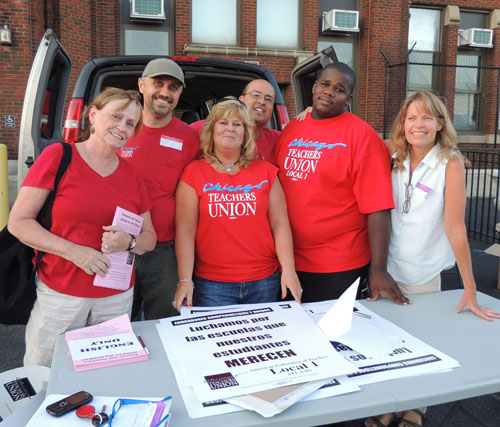 Beginning in 2011 and growing in 2012, the union was preparing thousands of teachers for the display of union power that resulted in the unprecedented demonstrations during the seven-day September 2012 strike. Among those working to distribute and pick up strike signs at Lane Tech High School during the August 22 meeting were (left to right) Bernice Eshoo (delegate Steinmetz High School), CTU field rep John Kugler, CTU staff member Kim Tarnow, Al Remirez (delegate Ruix Elementary School), Romel Ferguson (CTU staff), and Sharon Schmidt (Associate Delegate, Steinmetz High School and faculty advisor to the award winning school newspaper, the Steinmetz Star). Substance photo by George N. Schmidt.The Board’s refusal to take our concerns seriously led you to issue a 10-day strike notice on August 22. On September 10, 30,000 strong took to the streets and Chicago experienced its first teachers strike in 25 years. Who can forget the sheer power and magnitude of our strike? Reporters converged on Chicago from all over the nation to share our story and the sight of CTU red with the world. Thousands of dollars poured in from around the country into a solidarity fund. Rank and file members became the new heroes of the labor movement. We stayed on strike until victory was assured.
Beginning in 2011 and growing in 2012, the union was preparing thousands of teachers for the display of union power that resulted in the unprecedented demonstrations during the seven-day September 2012 strike. Among those working to distribute and pick up strike signs at Lane Tech High School during the August 22 meeting were (left to right) Bernice Eshoo (delegate Steinmetz High School), CTU field rep John Kugler, CTU staff member Kim Tarnow, Al Remirez (delegate Ruix Elementary School), Romel Ferguson (CTU staff), and Sharon Schmidt (Associate Delegate, Steinmetz High School and faculty advisor to the award winning school newspaper, the Steinmetz Star). Substance photo by George N. Schmidt.The Board’s refusal to take our concerns seriously led you to issue a 10-day strike notice on August 22. On September 10, 30,000 strong took to the streets and Chicago experienced its first teachers strike in 25 years. Who can forget the sheer power and magnitude of our strike? Reporters converged on Chicago from all over the nation to share our story and the sight of CTU red with the world. Thousands of dollars poured in from around the country into a solidarity fund. Rank and file members became the new heroes of the labor movement. We stayed on strike until victory was assured.
Our continued advocacy on behalf of Chicago’s 405,000 public school students has finally pushed the media to take a critical look at many of CPS’ claims about charter performance and the need for disastrous school closings and the true impact it has on communities and the people who work and live in them. Newspaper editorials and commentaries now reflect CTU research on issues of poverty, class size and school privatization.
There were other CTU victories as well. We have gotten our house in order. This leadership got rid of the staff and officer perks and the excessive spending that had saddled the Union with debt. Under our administration we paid off a $2.9 million dollar loan that the union has been burdened with for two terms. And it should be noted that even with paying off this big loan and having an expensive strike — we have a $1 million surplus in our budget — now that doesn’t count paying for the extra House Meetings and other expenses. This is a significant accomplishment. The CTU finances should not be treated by anyone as a personal piggybank to “Live the Life of Riley,” as my father used to say. Those resources are entrusted by the membership for us to be able to advocate on their behalves.
And advocate we did. Even though no contract will be 100 percent perfect, our contract campaign was successful. We created the Big Bargaining Team—and when I say “big,” I mean big. This was something the Board had never seen before. The Team had a broad cross-section of members from every aspect of our profession. United. One voice. It included members of every single caucus within the CTU. We are the experts after all, and so the Big Bargaining Team was instrumental in winning some of the ground breaking gains we now have in our new contract.
• We stopped merit pay, which is taking the nation by storm and leaving most teachers in urban districts with no raises at all. We stopped this scheme dead in its tracks. We did this because not only does it not work, but it is also an insult to who we are as educators. • While we had to take on a Wellness program that is inconvenient, we did fight off the worst parts of it and made it less burdensome. We did it so that unlike contracts from across the city, state and country – we could freeze our health care costs and freeze co-pays. We also strengthened our LMCC to give it binding powers to put pressure on vendors and insurers to improve services and programs that address the needs of our members. • We removed language from the contract that automatically increases health costs if the price per member per month for the CPS health benefits program went above 5 percent in a one year period. So we will not be seeing any future increases during this contract despite recent reports that insurance companies are raising rates by as much as 25 percent in California, Florida and New York. • In section 44-53 of the Tentative Agreement, we secured language that says no new paper-work requirements can be imposed on our members that is not required by law without eliminating a commensurate amount of already existing paperwork. This means that you should not have any additional paper-work requirements that are not of a legal nature, unless there is a decline in the other paper-work you are currently required to do. • We have the ability to do our own lesson plans. • Our students will now have access to textbooks on day one.
• Social workers and counselors have private spaces to treat students, rather than doing it in the hall or some other common area.
• We removed language that did not guarantee our raises and allowed the Board to unilaterally cancel it. No more stealing of our raises. No more promising one thing and doing another. Our contract may not be perfect but it is the contract we all fought for and won. It is up to us to make it something more than words on pieces of paper. It is a strong agreement that can only be made stronger when you ensure it is enforced in your schools.
Give yourselves a round of applause.
No other profession has the responsibility as great as those of us whose primary job it is to teach, to inspire, and to motivate young people—whose lives are rooted in systemic poverty. Students living in or experiencing childhood poverty are much more likely to face significant unaddressed obstacles to classroom learning than their middle- and upper-income counterparts, and this impacts educational outcomes. In fact, data show that family income is now the most significant predictor of academic success among students in the U.S.
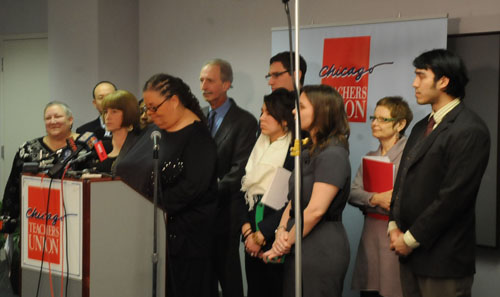 Six months before the Chicago Teachers Strike of 2012, on February 16, 2012, CTU President Karen Lewis joined with national and local researchers and education leaders to announce the publication, by the union, of "The Schools Chicago's Students Deserve," the first of many major studies produced through the CTU Research Department in cooperation with local and national scholars. Above, left to right, Julie Woestehoff (Chicago PURE), Carol Caref (CTU Research Department Coordinator), Karen Lewis, Monty Neill (head of Fair Test), CTU Vice President Jesse Sharkey, CTU Financial Secretary Kristine Mayle, University of Illinois Professor Pauline Lipman, and CTU researcher Pavlyn Jankov. Substance photo by George N. Schmidt.So brothers and sisters we must force the discussion about poverty every time they want to force the discussion about school reform. We must call out the “fat cats” who do not understand what it means to go to school hungry or to walk through a neighborhood smothered in violence and social despair. They don’t understand that these schools, the buildings in which we teach, are safe havens to so many of our students—that it is there that they find the nurturing, support and stability they need and deserve.
Six months before the Chicago Teachers Strike of 2012, on February 16, 2012, CTU President Karen Lewis joined with national and local researchers and education leaders to announce the publication, by the union, of "The Schools Chicago's Students Deserve," the first of many major studies produced through the CTU Research Department in cooperation with local and national scholars. Above, left to right, Julie Woestehoff (Chicago PURE), Carol Caref (CTU Research Department Coordinator), Karen Lewis, Monty Neill (head of Fair Test), CTU Vice President Jesse Sharkey, CTU Financial Secretary Kristine Mayle, University of Illinois Professor Pauline Lipman, and CTU researcher Pavlyn Jankov. Substance photo by George N. Schmidt.So brothers and sisters we must force the discussion about poverty every time they want to force the discussion about school reform. We must call out the “fat cats” who do not understand what it means to go to school hungry or to walk through a neighborhood smothered in violence and social despair. They don’t understand that these schools, the buildings in which we teach, are safe havens to so many of our students—that it is there that they find the nurturing, support and stability they need and deserve.
This is why we continue to demand more social workers, nurses, psychologists, audio vision and hearing technicians and other clinicians. This is why we don’t want neighborhood schools shuttered and replaced with charter operations based on military social conditioning and business models. CPS has more than 100 of our schools in its sights. The Board, by its own admission, has declared “war” on us—all of us. Your school may not be on the list, but one of your brothers and sisters’ schools is. We have to show them that when you threaten the livelihood of a few, you threaten the livelihood of us all. If you are not engaged in our school closing fight, I suggest you reconsider your position. This is why, brothers and sisters, we cannot grow weary of the fight. Now is not the time to tire. Now is not the time to say “We’ve gotten our contract and so our work is through until the next time.” 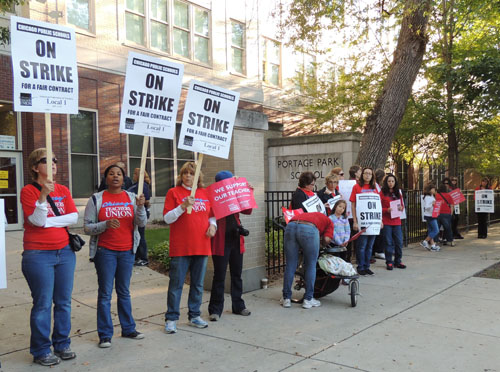 By September 10, 2012, the first day of the Chicago Teachers Strike of 2012, every real CPS public school was organized through the union to strike, despite a massive propaganda campaign aimed against the teachers and the union by the city's rulers, the Emanuel administration, and the corporate media. Shortly after dawn on September 10, 2012, pickets went up at more than 600 schools stretching across the third largest city in the USA. By seven a.m. on that first day, a new "symphony" of the strike began, with cars, trucks and other vehicles "Honk if you support the teachers..." across the city. Above, teachers and their supporters at Portage Park Elementary School. Substance photo by George N. Schmidt.This is the next time. Our pensions were under attack. Our profession is being assaulted. Our District is losing far too many experienced teachers. Public school educators are being blamed for everything that’s wrong with public education. And when they get tired of blaming us they turn on the parents for a while, and then the students themselves before returning the blame back to us.
By September 10, 2012, the first day of the Chicago Teachers Strike of 2012, every real CPS public school was organized through the union to strike, despite a massive propaganda campaign aimed against the teachers and the union by the city's rulers, the Emanuel administration, and the corporate media. Shortly after dawn on September 10, 2012, pickets went up at more than 600 schools stretching across the third largest city in the USA. By seven a.m. on that first day, a new "symphony" of the strike began, with cars, trucks and other vehicles "Honk if you support the teachers..." across the city. Above, teachers and their supporters at Portage Park Elementary School. Substance photo by George N. Schmidt.This is the next time. Our pensions were under attack. Our profession is being assaulted. Our District is losing far too many experienced teachers. Public school educators are being blamed for everything that’s wrong with public education. And when they get tired of blaming us they turn on the parents for a while, and then the students themselves before returning the blame back to us.
This IS the next time. This is YOUR time.
German Pastor Martin Niemöller is credited with the following poetic: “First they came for the Jews and I did not speak out because I was not a Jew; then they came for the communists but I did not speak out because I was not a communist; then they came for the trade unionist and I did not speak out because I was not a trade unionist; then they came for me and there was no one left to speak out for me.”
This is your time. Your moment in history. And I conclude: so where do we go from here?
Lois Weiner writes in her new book “The Future of Our Schools:
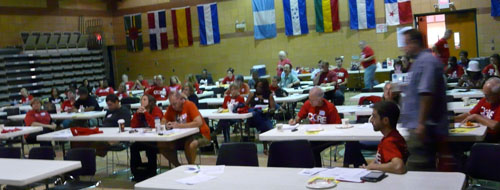 For more than 70 years, the Chicago Teachers Union has been characterized by a robust democratic process. The union's House of Delegates and Executive Board reflect the broad bases of the union's membership, with delegates elected from every school and "unit" and executive board members elected to represent the largest groups in the union proportionately. Within that democratic structure, the union has long hosted a number of "caucuses," which are fundamentally political parties within the union. In June 2010, the CORE caucus, led by Karen Lewis, defeated the United Progressive Caucus, then led by Marilyn Stewart (who almost immediately retired on an annual pension of more than $120,000 per year thanks to the inflated pay and perks she had provided to herself and the union staff during her six years as president). CORE (the Caucus Of Rank and file Educators, www.coreteachers.org) promised to be a new kind of caucus, practicing democracy at every level and throughout the year, not just forming during union elections. Above, the CORE annual convention on August 19, 2012 at Daley College in Chicago. Substance photo by Kati Gilson.”The future of the movement depends on activists realizing that they, not staff or officers on the state and national levels have to be the catalysts for change. Just as there is no escape from building the union at the base, there is no getting around the hard work of developing authentic alliances with parents and community activists, coalitions that acknowledge historic inequalities and support communities in their needs, rather than being paper organizations that are dusted off when the union wants to displace community support.”
For more than 70 years, the Chicago Teachers Union has been characterized by a robust democratic process. The union's House of Delegates and Executive Board reflect the broad bases of the union's membership, with delegates elected from every school and "unit" and executive board members elected to represent the largest groups in the union proportionately. Within that democratic structure, the union has long hosted a number of "caucuses," which are fundamentally political parties within the union. In June 2010, the CORE caucus, led by Karen Lewis, defeated the United Progressive Caucus, then led by Marilyn Stewart (who almost immediately retired on an annual pension of more than $120,000 per year thanks to the inflated pay and perks she had provided to herself and the union staff during her six years as president). CORE (the Caucus Of Rank and file Educators, www.coreteachers.org) promised to be a new kind of caucus, practicing democracy at every level and throughout the year, not just forming during union elections. Above, the CORE annual convention on August 19, 2012 at Daley College in Chicago. Substance photo by Kati Gilson.”The future of the movement depends on activists realizing that they, not staff or officers on the state and national levels have to be the catalysts for change. Just as there is no escape from building the union at the base, there is no getting around the hard work of developing authentic alliances with parents and community activists, coalitions that acknowledge historic inequalities and support communities in their needs, rather than being paper organizations that are dusted off when the union wants to displace community support.”
This is the new CTU. We are the national model for teachers unions around our great country. Now I recognize that the time before break may have been the hardest part of the school year for some of us. We are all just a little worn out! We just weeks removed from an exciting but energy intensive strike that put us on the world map. We retained critical parts of our contract; limited the emphasis of tests on teacher evaluation; maintained our salary schedule; reduced the length of Rahm’s longer day; added 600 art, music and world language teachers to the rolls; and, provided a series of new rights on the job that we never possessed before. So I understand being just a little tired.
However despite our wins, we have also returned to schools that are besieged with continuous mandates from the new evaluation and teacher practice systems, a longer day, the Common Core requirements, out-of-control testing demands on us and our students, school closing threats, charter expansion, and a general under-appreciation of what we do every-day as educators. Our work is not over, CTU. We have much more to do and a longer way to go.
This is your time, CTU. This is your time.
A CTU PRESS RELEASE ISSUED ON JANUARY 10 ALSO SUMMARIZED THE SPEECH FOR THE MEDIA, WHICH IGNORED THE PRESS RELEASE:
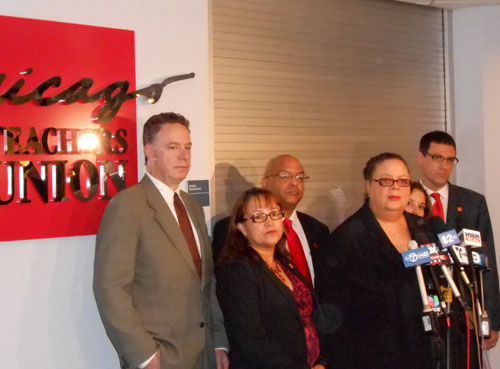 One of the main events during the second year of Karen Lewis's presidency of the Chicago Teachers Union was the warning, issued on Friday September 7, 2012 (above) that the union was on the verge of striking because the Board of Education was continuing its demands for the abolition of union rights won over decades. Above, Lewis, the officers, the attorney, and head of the grievance department at the September 7 press conference at CTU headquarters. Substance photo by George N. Schmidt.Chicago Teachers Union President says Members Have ‘Shown the World We Can Speak with One Voice’ in State of the Union Address
One of the main events during the second year of Karen Lewis's presidency of the Chicago Teachers Union was the warning, issued on Friday September 7, 2012 (above) that the union was on the verge of striking because the Board of Education was continuing its demands for the abolition of union rights won over decades. Above, Lewis, the officers, the attorney, and head of the grievance department at the September 7 press conference at CTU headquarters. Substance photo by George N. Schmidt.Chicago Teachers Union President says Members Have ‘Shown the World We Can Speak with One Voice’ in State of the Union Address
CHICAGO— With the city of Chicago at the forefront of education around the globe in 2012, Chicago Teachers Union (CTU) president Karen GJ Lewis reflected on a year of tremendous growth and transformation in her State of the Union speech on Wednesday night before the House of Delegates. Lewis expressed heartfelt pride in the work of union members and exhorted them to continue their efforts against imminent attacks on Chicago neighborhood schools and the privatization of public education in 2013.
“We remain undivided, and we remain unapologetic for demanding the respect we deserve,” Lewis said. “Our team is one that believes in justice, and we believe in confronting those who seek to put thousands of us out of work, shut down our schools and destabilize our students and communities.”
No other profession but teaching has a responsibility as great as those whose primary job is to teach, inspire and motivate young people—especially those mired in systemic institutional poverty, said Lewis, who took office in June 2010. “When we see a kid not paying attention, we know there’s something else going on,” she said. “It’s not that we’ve bored them—it’s that they are consumed by their own lives,”
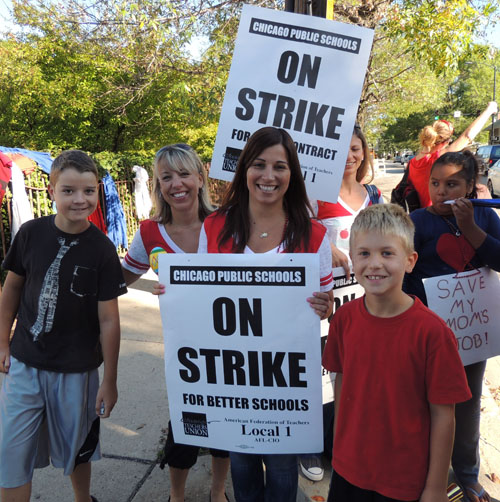 Two years of organizing under the new CTU leadership brought picket lines out at more than 600 real Chicago public schools on September 10, 2012, the first day of the strike. Above, Sam Schmidt (left, in black shirt) and Josh Schmidt (right, in CTU red) stand firmly with their teachers Betsy Plummer and Holly Pruett at O.A. Thorp Elementary School on Chicago's northwest side. On the first day of the strike, a handful of the children in Chicago went to the CPS Scab Centers ("Children First Sites"), but by the second day of the strike, most of the children who had gone into the Scab Centers had come out and joined the picket lines. There were a handful of scabs, and the sad members of the other unions that had settled with CPS out of fear of Rahm, Emanuel and therefore ordered their members to cross the teachers union's picket lines. Substance photo by George N. Schmidt.In the fight to save public education and public assets, the CTU has made the distinct connection between teachers unions and real education social justice through the work of various sectors of research, organizing and communications, Lewis said. Following a successful strike and contract campaign in 2012, the union continued to oppose Chicago Board of Education efforts to impart divisive and abusive policies on the public, such as disputing a Chicago Public Schools (CPS) claims of 145,000 “lost” school-age children since 2000—a figure that, according to CPS’s own data, was really between 25,000 and 30,000.
Two years of organizing under the new CTU leadership brought picket lines out at more than 600 real Chicago public schools on September 10, 2012, the first day of the strike. Above, Sam Schmidt (left, in black shirt) and Josh Schmidt (right, in CTU red) stand firmly with their teachers Betsy Plummer and Holly Pruett at O.A. Thorp Elementary School on Chicago's northwest side. On the first day of the strike, a handful of the children in Chicago went to the CPS Scab Centers ("Children First Sites"), but by the second day of the strike, most of the children who had gone into the Scab Centers had come out and joined the picket lines. There were a handful of scabs, and the sad members of the other unions that had settled with CPS out of fear of Rahm, Emanuel and therefore ordered their members to cross the teachers union's picket lines. Substance photo by George N. Schmidt.In the fight to save public education and public assets, the CTU has made the distinct connection between teachers unions and real education social justice through the work of various sectors of research, organizing and communications, Lewis said. Following a successful strike and contract campaign in 2012, the union continued to oppose Chicago Board of Education efforts to impart divisive and abusive policies on the public, such as disputing a Chicago Public Schools (CPS) claims of 145,000 “lost” school-age children since 2000—a figure that, according to CPS’s own data, was really between 25,000 and 30,000.
As the March 31st deadline for the announcement of up to 100 school closings approaches, Lewis called for continued solidarity in the name of democracy, and said the united voices of teachers, paraprofessionals and clinicians must remain unafraid to speak for themselves and for their students.
“We have to show all of them that if you threaten the livelihood of a few, you threaten the livelihood of us all,” she said.
?
Comments:
By: Jay Rehak
Speaking Truth to Power
President Lewis spoke eloquently in the House of Delegates Wednesday. Her words resonated with me; I was moved on May 23rd when I saw the Sea of Red at the Auditorium, and then later when we struck to try and hold the line on the privatization of our public assets.
While I have been impressed with the current leadership's willingness to speak truth to power, I am most impressed with the Research Department of the CTU.
It is great to have the facts behind us. I'm certain that in the days ahead President the right wing media and their wealthy owners will "call out" President Lewis for the frank language she uses. But the facts speak for themselves and I am grateful that the CTU leadership has the wisdom to back their words with solid evidence generated by their top notch research department. It makes it that much harder for those who wish to destroy public education through sophistry.


By: Jean Schwab
Poverty means children need more community services now
Poverty is one reason that students have trouble focusing, so instead of spending all this money starting new charter schools, why doesn't CPS spend money on working with the communities and neighborhood schools to strengthen services, such as medical services and improve the neighborhood by adding new job opportunities?